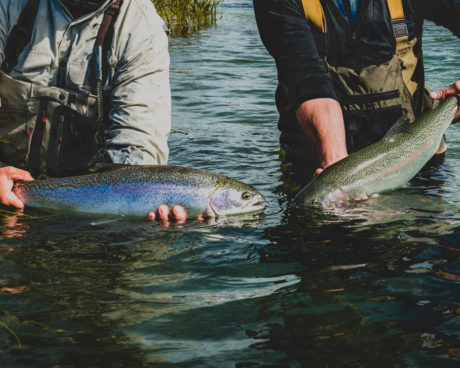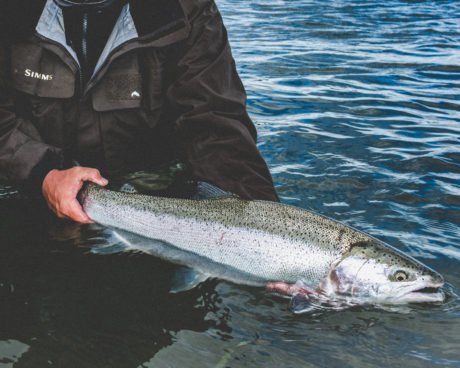When swinging flies most anglers are focused on the down and across presentation and are fishing more of the mid to latter portion of their swing. This may simply be because the steelhead that are classically being targeted by these swung fly anglers are notorious for taking in the latter half of the swing more on the inside. Whether this is due to the fact that the fly is easiest for the average angler to control in the softer flows of the edges or it maximizes its depth and convenience to be eaten is anybody’s guess. Today we will discuss fishing the first half of the swing and working the dead drift into a rising engagement through mid river traveling lanes.

The first half of the swing can be just as productive if done correctly. The first key to fishing the first half of the swing is that the fly must remain downstream of the fly line at all times. If the fly at any point ends upstream of the fly line it will accelerate towards the fish often times spooking them but once in a very very great while resulting in a dynamic memorable take. We aren’t focused on the anomaly take, and while occasionally a pleasant surprise the downstream acceleration cannot be relied on to consistently produce fish.
I’ve found that casting quite square just short of the fastest piece of current is a great way to setup this sort of presentation. I rarely mend in this scenario as that lifts everything that’s already sinking reducing the depth the presentation can achieve. The only time I mend is if the fly lands even slightly upstream of the fly line. Even then it is a very minimal mend. Just enough to straighten the operation.

Once settled take steps with the fly keeping the rod tip high with a controlled amount of slack. Tension is your enemy at this point. Keep as much tension off the line as possible while still maintaining slight contact. Just enough that the line remains somewhat straight with a minute almost imperceptible pull. During this portion of the swing the fly is essentially on a controlled dead drift it is going downstream and has not yet begun its crosscurrent travel. The sinking is maximized at this time and the fly will fall as deep as you allow it. That portion is up to you and your assessment of the depth, current speed, and sink rate of your fly and fly line.
The next portion of the presentation is the critical portion where the fish is most likely to eat. Once sufficient depth has been achieved it’s time to give the fly line tension and bring it across. When tension is applied the fly line and fly line go from a dead drift into a rising swing up and across the water column. This is where the chase response in your prey is engaged. It has seen the fly slowly sinking down and traveling towards it getting deeper and closer with each second. Most intruder style flies we swing are not designed to be dead drifted. They are designed for moving current flowing from the nose to tail of the fly. When dead drifting they are often a wiggly blob with no defined shape, a mass of color and material fluttering through the water column. The moment you begin to bring everything under tension the fly closes and becomes a defined shape and swims the way it was intended. It has gone from a blob to a defined teardrop shape alive with movement that could represent squid, shrimp, baitfish and a whole host of other prey items. The split second it becomes a recognizable prey item it is now fleeing away and up towards the surface. I think this engages the chase response in a fish better than simply throwing a downstream mend and accelerating the fly away. The closing of the materials into a recognizable prey item as it accelerates away is key. It gives the fish a split second to decide to leave it or take it. The grab of the fish combined with the current across your fly line that is now bellying behind that fish produces some pretty serious pull. Just what we like!

This is just another way of presenting a swung fly. It focuses on more mid river fish, often traveling anadromous fish that are out of reach of a standard presentation. It is in no way and end all or the “best” way to present a fly. Swinging flies is highly situational and this is just another technique to add to your bag of tricks to make you a deadly angler across a wide variety of scenarios. Best of luck in your experimentation.
Leave a Reply